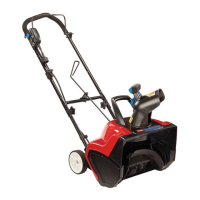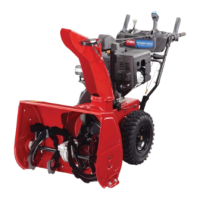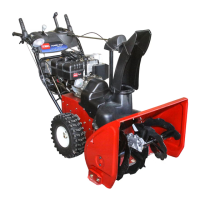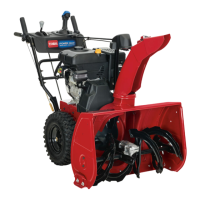8
POTENTIAL
HAZARD
•
The electrical cord can get damaged.
WHA
T CAN HAPPEN
•
A damaged electrical cord can cause a shock or
fire.
HOW T
O A
V
OID THE HAZARD
• Thor
oughly inspect electrical cord befor
e using
the snowthr
ower
. If the cord is damaged, do not
operate the snowthr
ower
. Replace or r
epair the
damaged cord immediately
. Contact your
Authorized Service Dealer for assistance.
Y
our snowthrower has a polarized plug, with one prong in
the handle socket being lar
ger than the other (Fig. 8).
When you insert the end of a suitable extension cord into
the handle socket, insert the enlar
ged prong into the wide
slot in the extension cord end. Refer to
Safety
on page 2
for additional information.
1540
1
Figure
8
1. Enlarged
prong
Operation
Before
Operating
1. Check
the condition of the snowthrower
. Make sure
the rotor turns freely
.
Starting
and Stopping
1. To
start the rotor
, squeeze the control bar (Fig. 9).
1535
1
Figure
9
1. Control
bar
2. To
stop the rotor
, release the control bar
.
Operating
T
ips
POTENTIAL
HAZARD
•
If snowthr
ower hits a for
eign object while in
operation, the object could be thr
own in
operator’
s or bystander
’
s dir
ection.
WHA
T CAN HAPPEN
• Thr
own objects can cause serious personal
injury.
• Snowthr
ower could be damaged.
HOW T
O A
V
OID THE HAZARD
•
Keep the ar
ea to be clear
ed fr
ee of all for
eign
objects which may be picked up and thr
own by
the r
otor blades.
•
Always keep children and pets away from the area of
operation.
•
Keep the area to be cleared free of stones, toys, or
other foreign objects which the rotor blades can throw
.
Such items could be covered by snowfall and go
unnoticed. If the snowthrower strikes an obstruction or
a foreign object during operation, stop the
snowthrower
, unplug the extension cord, remove the
obstruction, and check the snowthrower for damage.
• T
o adjust the dischar
ge chute, rotate the chute crank
clockwise to move the dischar
ge chute to the left;
counterclockwise to move the chute to the right.
Note:
The chute crank makes a noise as you turn the
crank. This is normal.
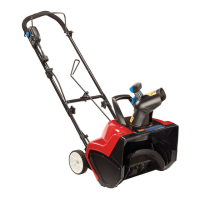
